2017 BMW R NineT Scrambler First Ride Review
The bike for hipster fathers
If you’re wanting to spend some quality time with your millennial hipster kid and think some shared motorcycle experiences are the way to do it, but you don’t want to relive your ownership of a Honda CB400, and have the means to afford a shiny new two-wheeler even the youthful bearded crowd will have a hard time pooh poohing, BMW’s new R NineT Scrambler might be for you.
2017 BMW R NineT Scrambler
| Engine | 17.75/20 |
| Suspension/Handling | 10.0/15 |
| Transmission/Clutch | 9.5/10 |
| Brakes | 7.5/10 |
| Instruments/Controls | 2.5/5 |
| Ergonomics/Comfort | 8.5/10 |
| Appearance/Quality | 9.5/10 |
| Desirability | 8.5/10 |
| Value | 7.5/10 |
| Overall Score | 81.25/100 |
It seems as though BMW was caught off guard by the success of the original R NineT (launched in 2013 to commemorate the 90th anniversary of the R 32, BMW’s first motorcycle), which might explain why it took three years to follow up with the Scrambler model. With the announcement of two new R NineT models for 2017, BMW is now quickly capitalizing on its own heritage as well as the prevailing trend in heritagesque.
At $13k, the Scrambler comes in $2,100 under the standard NineT’s $15,095 price tag. To reach this lower threshold, the Scrambler had to endure a few cust-cutting measures, most of which do not adversely affect the Scrambler’s performance – except for one or two, and we’ll get to those shortly. For easy comparison sake, the most notable differences are referenced in the chart below.
| R NineT | R NineT Scrambler | |
| Front Wheel | 17-inch | 19-inch |
| Claimed Curb Weight | 459 lbs | 463 lbs |
| Seat Height | 30.9 inches | 32.3 inches |
| Wheelbase | 58.2 inches | 60.0 inches |
| Fuel Tank | Aluminum | Steel |
| Front Suspension | Inverted 46mm telescopic fork | Traditional 43mm telescopic fork |
| Wheels | Cross-spoke | Cast |
Good thing is, both NineT’s share the same engine performance. The air/oil-cooled 1170cc boxer-Twin may not equal the output of its liquid-cooled cousins, it nonetheless gets the job done with oodles of low-end, torquey grunt, as well as sporty thrust. Sans tach, it takes a while to fully understand the engine’s preferences, especially with its ability to spin freely – surprisingly – to its rev-limiter. Eventually, though, engine sound and feel are learned, allowing its rider to execute proper gear selection for the given situation.
2014 BMW R NineT First Ride Review
While our two-day ride around rurals of New Jersey and the urban jungle of Manhattan was mostly an affair with asphalt and potholes, BMW did graciously include some off-roading befitting the nature of 500-pound scrambler. Most of both were of the higher-speed variety, but when it came time to tip-toe around a series of mud puddles (my attire did not include the term waterproof) or brake hard then point-and-shoot through New York traffic, the Twin made easy work of either situation, even if stuck in a gear too high.
Barreling down one of the longer stretches of dirt at a 75 mph clip, praying one or both of the wheels don’t explode when striking the hard-to-see chuckholes littering the road (one journo did bend a front cast rim), it becomes apparent the NineT Scrambler is only meant to be ridden while standing for short distances. The Scrambler does have higher handlebars compared to the standard model, but it still requires you to maintain a crouched, attack position. Sitting down means slowing down, and here’s why.
2017 BMW R NineT Pure And R NineT Racer Previews
Four-point-nine inches of fork travel (only 0.2 inches more than the standard NineT) simply isn’t enough travel to contend with modest-size impacts. A situation exacerbated by the cost-saving, non-adjustable traditional 43mm fork on the Scrambler replacing the inverted 46mm fork of the standard NineT. Regardless of fork travel, anything short of smooth pavement proves the Scrambler’s fork to be harsh. I’ve ridden with better-sorted front suspension on bikes costing half as much.
The rear shock with 5.5 inches of travel is better able to deal with urban assaulting or mild off-roading. The shock’s preload is adjustable by way of old-school locknuts requiring a screwdriver and hammer to adjust. A conveniently placed twistie knob for hydraulically adjustable preload is preferable, but that type of convenience may detract from the heritage experience and costs extra.
The base model Scrambler comes equipped with cast aluminum wheels rolling on Metzeler Tourance tires. The tubeless cross-spoke wheels are a $400 option, and the off-roady Metzeler Karoo 3 tires are optional too, but for no extra charge. According to BMW, differently outfitted bikes will be available in BMW dealerships, however you’re more likely to find Scramblers outfitted with spokes and Karoo tires, which seems appropriate because that’s the way a Scrambler should look.
However, it certainly deserves noting that those big-block Karoos do funny things to the bike’s handling on pavement. Grip isn’t the problem, more so the tires’ willingness to bend into corners, change lean angles, and smoothly continue a chosen arc. The Karoo’s idiosyncrasies had largely become minor background noise by the end of our second day, but they do take some getting accustomed to. Speaking of noise, at anything above 30 mph, those big-block Karoos whirl with the sound of a semi-tractor trailer. It’s a noisy, tough sound in a cool sort of way.
There are differences in the frame, wheelbase, rake/trail, and front tire size between the standard NineT and Scrambler which could affect the Scrambler’s handling. With no Scrambler available at the launch outfitted with the Tourance tires, it must be assumed the Scrambler handles normally on pavement when big-block tires aren’t involved. Otherwise, BMW would have a larger problem on its hands, and we doubt that’s the case. Once we get a Scrambler in our possession for more testing, we’ll report our findings then.
Claiming 463 curb pounds, the scrambler outweighs its stablemate by a scant four pounds. While that’s not exactly dirtbike-light, it is lighter than the big 600-plus-pound adventure bikes we tested a few weeks ago. Similar to its GS brethren, the nature of the flat-Twin has the scrambler carrying its weight low, making the bike seem lighter than its curb weight implies.
I was going to say “rowing” the gearbox, but gear selection isn’t always crucial to the Scrambler’s ability to execute a task, given the flexibility of its engine. So let’s say occasionally shifting the gearbox was a smooth and positive process with no missed gears or false neutrals. The hydraulically actuated single plate dry clutch has an easy pull and engages through a friction zone that’s conducive to easy clutch feathering.
BMW’s presentation of the R NineT Scrambler included the interesting factoid that for 9% of buyers, the standard NineT was their first motorcycle. Not first BMW motorcycle, their first motorcycle ever. A 1200cc bike costing $15k may not seem like the perfect first bike, but it makes more sense when it’s revealed that the average age and income of R NineT buyers is 53 years and $150k-$175k annually.
With the Scrambler, BMW is hoping to reach a wider audience with a more affordable model. For those first-time buyers, the front suspension issue will largely go unnoticed, but the seasoned riders it’ll probably be something you’d want to fine-tune out of the bike. Otherwise, the R NineT Scrambler is a bike that’d make any hipster son proud of his father for owning.
2017 BMW R NineT Scrambler
+ Highs
- Free knobby tires!
- Easily customizable
- Single-side swingarm + high pipes = sexy
– Sighs
- Knobby tires aren’t pavement friendly
- Budget front suspension
- No tach on a $13k motorcycle?
2017 BMW R NineT Scrambler Specifications | |
|---|---|
| MSRP | $13,000 |
| Horsepower (claimed) | 110 hp @ 7,750 rpm |
| Torque (claimed) | 86 lb-ft @ 6,000 rpm |
| Engine Capacity | 1170cc |
| Engine Type | Flat Twin |
| Bore x Stroke | 101mm x 73mm |
| Compression | 12.0:1 |
| Fuel System | EFI |
| Transmission | Constant-mesh 6-speed |
| Clutch | Hydraulically actuated dry clutch |
| Final Drive | Shaft |
| Frame | Tubular space frame |
| Front Suspension | 43mm telescopic fork |
| Rear Suspension | Paralever |
| Front Brakes | 320mm dual disc |
| Rear Brakes | 265mm single disc |
| Front Tire | 120/70-19 |
| Rear Tire | 170/60-17 |
| Seat Height | 32.3in |
| Wheelbase | 60.1in |
| Curb Weight (claimed) | 585 lbs |
| Fuel Capacity | 4.5 gal |
| Electronics | ABS, ASC (optional) |
| Colors | Monolith Metallic Matte |
A former Motorcycle.com staffer who has gone on to greener pastures, Tom Roderick still can't get the motorcycle bug out of his system. And honestly, we still miss having him around. Tom is now a regular freelance writer and tester for Motorcycle.com when his schedule allows, and his experience, riding ability, writing talent, and quick wit are still a joy to have – even if we don't get to experience it as much as we used to.
More by Tom Roderick



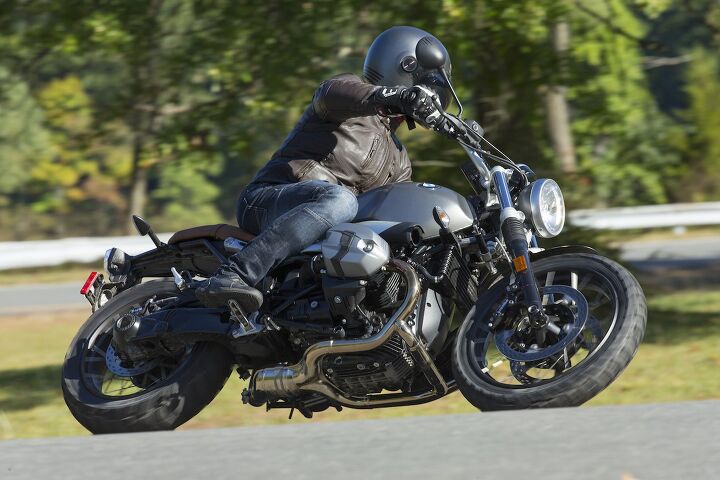

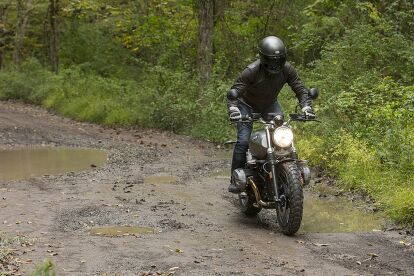


















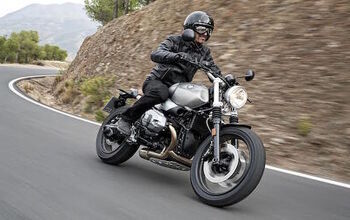


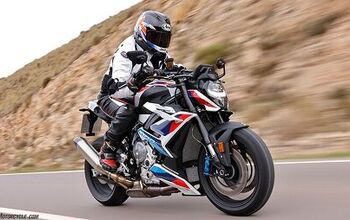
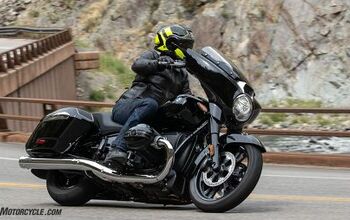









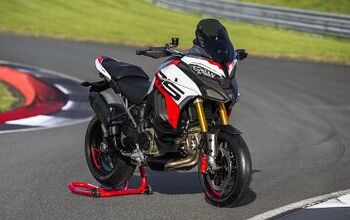


Comments
Join the conversation
If BMW made a serious effort to put a proper Bavarian spin on the scrambler motif, they would have put quality, adjustable, perhaps even optional electronic suspension on it to counteract the weight, more than a speedo with a simple LCD readout (which is similar to a Sportster's, sad), nothing but strong, spoked wheels, and a price significantly north of the standard R nine T. You know, as a kind of manageable GS alternative with lower seat height, no fairing, non-ADV lighting, etc. Instead they have an almost guaranteed failure delivering "affordability" from a brand that has made no bones about being a premium producer for many years. (I'm not so sure the G310 is going to be priced like the $5k club.) They saw Ducati (the only real scrambler-y success so far, and not through that ridiculous $7k Sixty anomaly; even Triumph hasn't sold THAT many as opposed to Bonnies lately) and said, "hmm..." and tried to cut from an already squeezed (though in actuality a pretty profitable product? dunno. does it cost a similar amount to build an R1200 as an S1000?) platform in the air/oil-cooled R Nine T. After successive motorcycle shows over the last few years, it seems that too many manufacturers are spreading themselves too far hoping to snap up any, ANY stragglers or hold-outs for their "perfect mashup." I get that it's not so hard to change things in assembly to go with trends, but it speaks to a lack of focus and confidence. Too much choice is crippling. Hear that, Yamaha? It would have been okay not to have done the SCR950. It wasn't incumbent on you. Nor do you have to do that to the FZs! Choppers've got that stuff covered!
Yeah, I don't understand the lack of a tach, especially given the target market.
Then again it's BMW, so maybe they'll make it a $600 option...